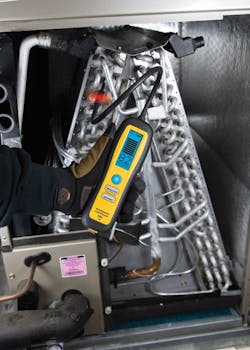If you work with large HVACR systems, you know one thing: They all leak at some point. Finding and repairing those leaks is critically important to maintaining a healthy system. But, before you can fix a leak, you need to find it. That’s where leak detectors come in.
If your HVAC system is losing refrigerant, the first tools you can use are your eyes and ears. Start by looking around for oil stains and listen for pinhole leaks near weld joints or other connections. If you don’t see or hear anything, the leak is probably very small. Soap bubbles and UV dyes are two effective ways of finding leaks, but they do have drawbacks. For one, they can both be messy. Plus, you usually need a direct line of sight to see small leaks.
Infrared, heated diode and ultrasonic sensors are three versions of leak detectors that can immediately detect the presence of refrigerant.
Since refrigerant is heavier than air, it flows down from the leak and settles in low areas. It also dilutes within a few seconds. Knowing how gas acts actually helps us find the source of the leak. If your electronic detector sniffs any presence of refrigerant, it will beep or light up. Once you’ve detected the presence of refrigerant, start by slowly moving your detector from low spots to high until the detector stops beeping. Repeatedly doing this helps you pinpoint the location of even the smallest pinhole leaks.
How slowly should you move the detector? About three inches per second. Yes, that’s really slow. But this deliberate, methodical movement ensures that you aren’t creating a breeze that affects the detection of a leak. It also allows leaking refrigerant enough time to reach the sensor and react. To confirm that you have found the leak, move the detector to clean air and back over the suspected leak location to make sure the detector alarms again.
Leak detectors are becoming more and more sensitive, but the best way to take advantage of these new advances is to make sure that you always use them correctly.
Tony Gonzalez is Technical Training Manager at Fieldpiece Instruments (www.fieldpiece.com). He has more than 20 years of industry experience with Fieldpiece developing new products.
About the Author
Tony Gonzalez
Technical Training Manager
Tony Gonzalez is Technical Training Manager at Fieldpiece Instruments (www.fieldpiece.com).
He has more than 20 years of industry experience with Fieldpiece developing new products. Most recently, he led the Job Link® App development team and developed Fieldpiece’s wireless power clamp meters. He is committed to training on best practices to help the HVACR professional do their job easier, faster and better.
Tony enjoys road cycling and rooting for his hometown LA Dodgers.

